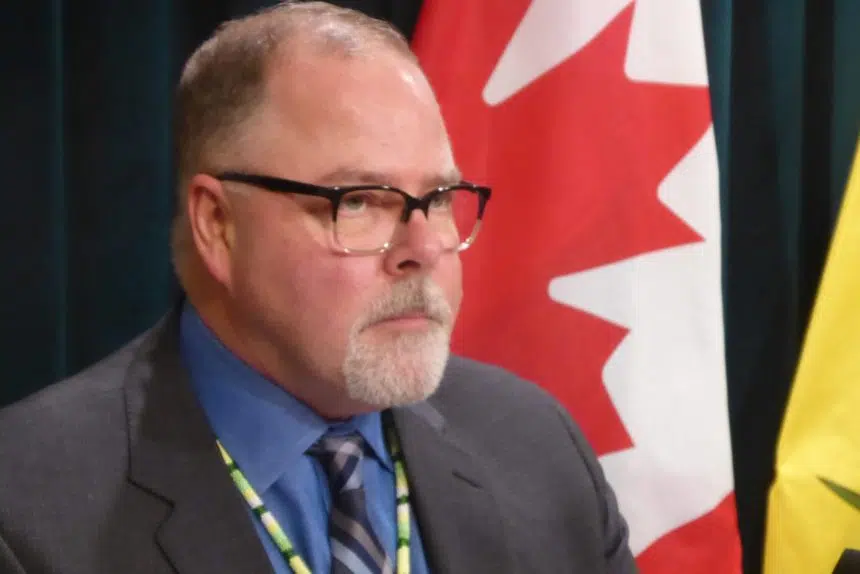The Saskatchewan Health Authority estimated Tuesday that its supply of some personal protective equipment will last for about a month.
In a weekly update, the SHA said the province currently has “approximately a one month or more supply of most essential PPE items, including surgical masks, N95 respirators and gloves” as it continues its battle against COVID-19.
The authority said it’s still purchasing supplies through its regular channels and is working with the federal government to get any equipment purchased by the feds for the province.
SHA CEO Scott Livingstone told reporters on a conference call that the authority is constantly monitoring the rate of consumption of its PPE. A move by the SHA on Tuesday may have a positive impact on that supply as well.
“With the announcement today to go to continuous masking, there is sort of an offset with respect to the number of masks that we’ll use,” Livingstone said.
“Today, people may don a mask and then move out of an area and discard it because they might not think that they’re coming back into that area. But with the continuing masking policy, we feel that we do have enough masks to provide that, not just for ourselves but for our affiliates and with other partners.”
The SHA’s new screening and masking requirements for health-care providers are to take effect Wednesday.
The authority said staff, physicians, learners, trainees, vendors and contractors will be screened daily as they enter SHA facilities to make sure they don’t have any influenza-like illness. As well, everyone who works in care areas or travels through those areas must wear a mask at all times.
The SHA has partnered with the University of Saskatchewan’s Vaccine and Infectious Disease Organization-International Vaccine Centre (VIDO-InterVac) in hopes of finding a way to decontaminate and reuse N95 respiratory masks that normally are thrown away after each use.
The new masking and screening measures will be used at long-term care facilities, hospitals, primary care sites and SHA affiliates.
The SHA reminded residents of other measures already in place, such as hand-washing, physical distancing, self-isolating, limiting the size of gatherings, and refraining from visiting hospitals and long-term care facilities.
The SHA also noted that its what-if scenarios, released April 8, remain the same as before. Livingstone noted the authority will “continue our current path of planning for the worst and aiming for the best.”
“There are encouraging signs of how the public distancing and the good work that our communities are doing to prevent the spread of COVID, but we don’t have a crystal ball so we don’t know what’s going to happen next week,” he added.
“Things are encouraging and as we move forward over the next week or two, we will have updated models and we will be sharing them and the plan would be adjusted.”
The SHA’s models laid out its plans for handling the pandemic, from the construction of field hospitals in Regina and Saskatoon to moving patients to other facilities to open up beds for patients in COVID-only hospitals.
Livingstone was asked if the cost of the preparation efforts to date had been calculated.
“Certainly on the ordering of PPE, we would be ordering three to four times what we normally would,” he said. “Unfortunately we are not paying the same prices we would normally, given the global issues around access to PPE.
“Certainly we haven’t got a running total yet but we are tracking the spend on COVID-19 and will continue to do so. A lot of that is going to be completely dependent upon how much of that phased-in plan is going to be put in place and how quickly it needs to be put in place to respond to what is happening with respect to patients in the province.”
The authority revealed it has increased its capacity for contact tracing to more than 250 full-time equivalent staff, well above the normal capacity of 62. Its plans call for more than 400 such employees if the need arises.
More locations in the province will be doing COVID laboratory testing to improve the turnaround speed of tests. Meadow Lake and Prince Albert have joined Regina and Saskatoon as testing locales, with more centres to come in the future.
Seven communities in Saskatchewan — Saskatoon, Regina, Moose Jaw, North Battleford, Prince Albert, Weyburn and Indian Head — now have assessment and treatment sites.
Livingstone was asked about the SHA’s reaction to a drive-in Easter church service that was planned in Nipawin, similar to one that was planned for Strasbourg.
He said members of the public raised concerns about the gathering because it exceeded the 10-person maximum put in place by the public health order. Livingstone said a public health inspector spoke to organizers and suggested, after finding out there weren’t any plans to protect people from gathering outside of their vehicles, that the event be cancelled.











